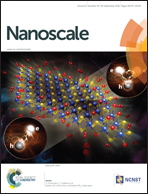Intimate organic–inorganic nanocomposites via rationally designed conjugated polymer-grafted precursors†
Abstract
Semiconducting organic–inorganic nanocomposites comprising the conjugated polymer poly(3-hexylthiophene) (P3HT) in intimate contact with CdSe nanocrystals were crafted by exploiting rationally designed P3HT-grafted cadmium precursors (i.e., Cd-P3HT complexes). The bifunctional ligand 4-bromobenzyl phosphonic acid (BPA-Br) that possesses two terminal functional groups at each end was employed, enabling the coordination of BPA-Br with Cd first to yield Cd-phosphonic acid complexes (Cd-BPA-Br) followed by the subsequent substitution of the bromide moiety into the azide (N3) group to form N3-functionalized Cd-phosphonic acid complexes (Cd-BPA-N3). Cd-P3HT complexes were then synthesized via a click reaction between Cd-BPA-N3 and ethynyl-terminated P3HT (P3HT–![[triple bond, length as m-dash]](https://www.rsc.org/images/entities/char_e002.gif) ). The success of the click reaction was confirmed by spectroscopic measurements. The morphology of CdSe nanocrystals (i.e., quantum dot and multi-branched) in P3HT–CdSe nanocrystal nanocomposites can be altered by tuning the concentration of Cd-P3HT complexes and the addition of excess Cd-BPA-Br (i.e., Cd-P3HT solely for the synthesis of CdSe quantum dots, and Cd-P3HT and Cd-BPA-Br at the ratio Cd-P3HT : Cd-BPA-Br = 1 : 1 for the synthesis of multi-branched CdSe nanocrystals). The photophysical properties of the resulting P3HT–CdSe nanocomposites were examined via absorption and photoluminescence studies. In comparison with P3HT–
). The success of the click reaction was confirmed by spectroscopic measurements. The morphology of CdSe nanocrystals (i.e., quantum dot and multi-branched) in P3HT–CdSe nanocrystal nanocomposites can be altered by tuning the concentration of Cd-P3HT complexes and the addition of excess Cd-BPA-Br (i.e., Cd-P3HT solely for the synthesis of CdSe quantum dots, and Cd-P3HT and Cd-BPA-Br at the ratio Cd-P3HT : Cd-BPA-Br = 1 : 1 for the synthesis of multi-branched CdSe nanocrystals). The photophysical properties of the resulting P3HT–CdSe nanocomposites were examined via absorption and photoluminescence studies. In comparison with P3HT–![[triple bond, length as m-dash]](https://www.rsc.org/images/entities/char_e002.gif) , the significant emission quenching of nanocomposites suggested the efficient charge transfer at the P3HT/CdSe interface. It is noteworthy that the implementation of judiciously synthesized Cd-P3HT complexes as precursors rendered the in situ synthesis of P3HT–CdSe nanocrystal nanocomposites, dispensing with the need for the use of insulating aliphatic ligands and tedious ligand exchange procedures for the preparation of functional polymer-tethered nanocrystals.
, the significant emission quenching of nanocomposites suggested the efficient charge transfer at the P3HT/CdSe interface. It is noteworthy that the implementation of judiciously synthesized Cd-P3HT complexes as precursors rendered the in situ synthesis of P3HT–CdSe nanocrystal nanocomposites, dispensing with the need for the use of insulating aliphatic ligands and tedious ligand exchange procedures for the preparation of functional polymer-tethered nanocrystals.


 Please wait while we load your content...
Please wait while we load your content...